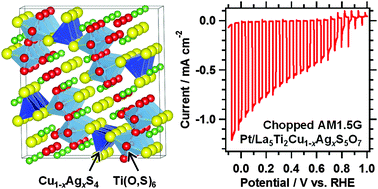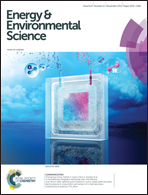La5Ti2Cu1−xAgxS5O7 photocathodes operating at positive potentials during photoelectrochemical hydrogen evolution under irradiation of up to 710 nm†
Abstract
A photoelectrochemical (PEC) cell based on a series-connected photocathode and photoanode made of particulate semiconductors is a potentially scalable and inexpensive device for renewable solar hydrogen production via PEC water splitting without any external power supply. The realisation of such PEC devices hinges on the development of photoelectrodes that operate at a small applied voltage. In this study, solid solutions of La5Ti2CuS5O7 (LTC) and La5Ti2AgS5O7 (LTA) were synthesised, and their physical, optical, and PEC properties in the water splitting reaction were discussed. LTC and LTA formed a La5Ti2Cu1−xAgxS5O7 solid solution (LTC1−xAx) over the whole compositional range. The indirect bandgap energy of LTC1−xAx changed nonlinearly with respect to composition, attaining its minimum value (ca. 1.8 eV) at a composition of x ≈ 0.16. Photoelectrodes of Al-doped LTC1−xAx solid solution powder fabricated using the particle transfer method exhibited a photocathodic response regardless of the Ag content. 1%Al-LTC0.9A0.1 photocathodes exhibited the best PEC properties in the hydrogen evolution reaction and yielded a hypothetical half-cell solar-to-hydrogen energy conversion efficiency of 0.25% at +0.6 V vs. RHE, three times higher than the previously reported 1%Sc-LTC. In addition, 1%Al-LTC0.9A0.1 photocathodes were fairly stable at +0.7 V vs. RHE without any protective modifications. Owing to the positive operational electrode potential of 1%Al-LTC0.9A0.1, unassisted PEC water splitting was accomplished using series-connected photoelectrodes made of 1%Al-LTC0.9A0.1 and BaTaO2N, particulate semiconductors with absorption edge wavelengths of 710 and 660 nm, respectively, at a Faradaic efficiency of unity and a solar-to-hydrogen energy conversion efficiency of approximately 0.1%.


 Please wait while we load your content...
Please wait while we load your content...